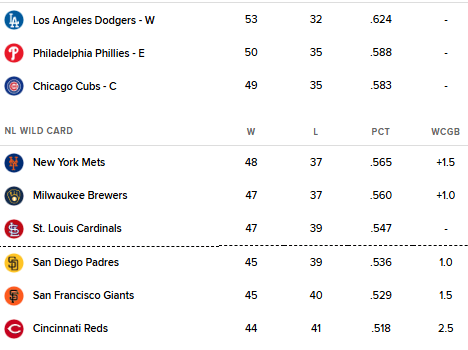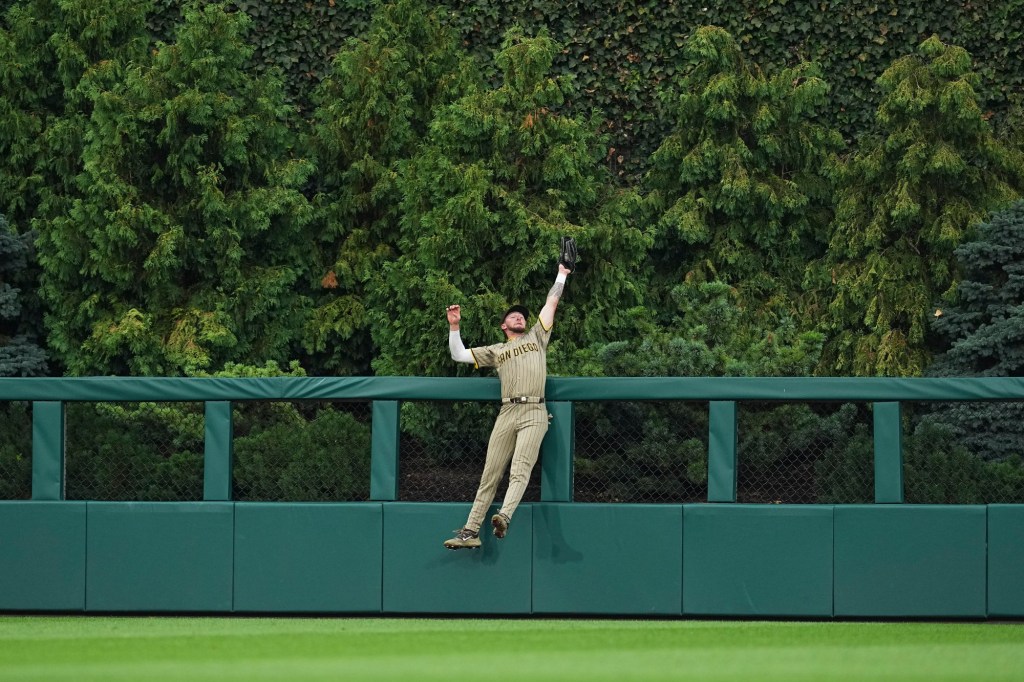Good morning from Philadelphia,
A little more than a year ago, Matt Waldron made one of the finest starts of his career here at Citizens Bank Park in a game the Padres badly needed to win.
Last night, in his first major league game of the season, Waldron was not as sharp and the Padres were not as desperate.
It stands to reason that Waldron will get another chance in the rotation after interspersing some really good knuckleballs along with some that got away from him while allowing four runs in 4⅓ innings .
As for the Padres as a whole, they have a while before they reach desperation mode. But time is running out on their offense as it is currently constructed.
You can read in my game story (here) about how Waldron’s outing unraveled and how the Padres were handled for eight innings by Zack Wheeler in a 4-0 loss to the Phillies.
It has become a challenge to keep coming up with new ways to convey how unproductive the Padres’ offense has been over the past 6½ weeks.
Here is my attempt for today:
Major League Baseball teams win nearly 73% of the time when they score at least four runs this season.
The Padres are 31-12 (.721) when they score at least four runs this season. Their 43 games scoring that much are eighth fewest in the major leagues, and they have done it just 18 times in their past 42 games.
They have gone 18-24 in that span and have fallen a season-high one game out of the final National League playoff position.

In an effort to avoid a further fall, it might be time to pull the trigger on a solution at catcher.
It has been stressed in this space repeatedly that whatever improvements the Padres make from outside will not have the desired impact if the top of the lineup doesn’t start producing at a higher level collectively.
That is a belief held by virtually everyone in the organization.
So is the idea they need help to give their offense some length and depth.
Manager Mike Shildt has certainly given the impression he could hardly care less what his catchers do at the plate as long as they are doing their jobs behind the plate.
That is not a belief held as deeply by everyone in the organization.
Especially as Martín Maldonado’s batting average has fluctuated between .163 and .194 since mid-May. It is currently .180, and he was lifted for a pinch-hitter last night in the fifth inning.
Shildt would not bite on questions regarding the potential competitive disadvantage his team is placed at by removing his catcher after one at-bat and spending a bench bat and a second catcher in the fifth inning.
There was no reason to push beyond a couple questions. Shildt doesn’t publicly criticize players or even come close to acknowledging their shortcomings for public consumption.
Besides, what he did say about pinch-hitting for Maldonado with two on and one out in the fifth inning of a game the Padres trailed 3-0 actually conveyed all we needed to know.
“It was a fairly easy decision, quite frankly,” Shildt declared.
He was not inserting Barry Bonds. It was not even Gavin Sheets or David Peralta that Shildt was inserting in the game before then having to use his second catcher of the night.
What Shildt called his “magic bullet” in that situation was Trenton Brooks, a 29-year-old who in his two stints in the majors leagues is now 5-for-38 (.132) with a double and a home run. (He did hit a pinch-hit homer off Matt Sauer in Los Angeles two weeks ago. He was facing Zack Wheeler last night.)
It is troublesome enough that Shildt has pinch-hit for Maldonado in nearly two-thirds of his starts, usually in the seventh inning or later but once before in the fifth inning.
To do it as early as he did last night is a major indictment on what Shildt is working with.
The Padres have been looking on the trade market not just for a right-handed bat to play left field (or be their DH) but also a catcher who can hitter better than what they have. There isn’t a lot out there. Maybe they can line up later. Or maybe the top of the order will heat up to the point they can actually survive with Maldonado catching half their games.
Or maybe they should give Luis Campusano a chance.
A real chance. Not the three games and then send him down kind of chance he got in early May. Or the chance a few weeks later where he pinch-hit once, served as the designated hitter in three of the next six games and then did not play for 11 days, then pinch-hit against a position player, then was the DH in a game four games later and then was sent back down to Triple-A.
This is not to say the 26-year-old Campusano is the answer. He is 0-for-18 with six walks this season. He has struck out nine times and grounded out to the left side of the infield five times. He has put three hard-hit balls in play.
There are not many left in the organization who still believe wholeheartedly he can be a major contributor. That is obvious.
But Campusano has the highest OPS (1.064) in the Pacific Coast League. The reports from there are also excellent regarding his effort and focus and his handling of the pitching staff.
And as meaningless as his Triple-A numbers might be, it’s not as if Campusano has not accomplished anything in the big leagues.
He entered this season having played in 168 MLB games. He was batting .250 with a .684 OPS.
Either he can play for the Padres, or he can’t. Given the circumstances, it is probably time to find out once and for all.
Learning, leaping
Jackson Merrill made his leaping catch at the wall to rob Max Kepler of a home run in the third inning look so easy that it might seem he has been practicing plays like that his whole life rather than just the past year-and-a-half.
The former shortstop, who worked on becoming a left fielder in the winter before last season and then became a center field in the spring before last season, played a solid center field in 2024.
But it wasn’t silky like this. It seemed strangely certain from the start that Merrill was going to catch Kepler’s 408-foot blast.
He glided back 78 feet, watching the ball over his shoulder the entire time, reached the wall, jumped and caught the ball about three feet above the wall before landing on the warning track and jogging back toward the dugout.
JACKSON MERRILL ARE YOU SERIOUS?! 🤯 pic.twitter.com/9zycPrPLvE
— MLB (@MLB) June 30, 2025
“I timed it up right and just went back smooth,” Merrill said. “I feel like last year I did a lot of sprinting to balls. You know, regardless of if they were hit far or short, I would just, like, sprint off the bat. So I saw it go up in the air and just wanted to be smooth, get back and give myself a chance.”
The play left Waldron in awe. He raised his arms in the air and said something like, “Oh my f—ing …” as he waited to confirm Merrill had made the catch.
“It was unbelievable,” Waldron said. “I knew the sound was pretty good, first pitch sweeper, and he hit it well, and I saw it, and I was just slightly devastated. And then he came up with it. I didn’t know he had it until probably ran in for another 150 feet.”
The entire time Merrill was jogging in, the second and third base umpires were waiting to make a call. As Merrill jogged past third base umpire Bill Miller, the crew chief asked to see the ball.
On his way back out to the field for the bottom of the fourth, he said to Miller, “I should show that immediately, huh?”
Merrill also sought out Kepler later in the game.
“I apologized to Max too,” Merrill said. “… I wasn’t trying to mess with him. It was just like, ‘I got it.’”
Rotation equation
Ryan Bergert threw a bullpen session yesterday at Citizens Bank Park on what would have been his scheduled start day.
Waldron took his place in the rotation and showed how committed he was to the knuckleball — throwing it 77 times in 104 pitches, his highest ratio (74%) ever.
Which one of them — or whether one of them — is in the rotation in a couple weeks depends on Waldron’s results and Yu Darvish’s rehabilitation.
“Matt is getting an opportunity tonight,” Shildt said before the game. “It’s the big leagues. … What happens in the big leagues with guys (is) that … they’ve got to continue to establish themselves. It’s always going to be somewhat fluid. … And we do have Darvish who is knocking back on the door.”
Darvish is expected to throw a simulated game of 60-plus pitches and four innings today in Lake Elsinore.
His being ready to make his season debut could potentially come around the time Bergert is eligible to come off the injured list (July 10).
Bergert, who has a 3.13 ERA in five starts, will likely make a rehab start this week.
Said Shildt: “He should be available to come back without anything outside of the ordinary when he’s eligible.”
Bergert was hit in the right forearm by a 103 mph line drive in his last start, Tuesday against the Nationals. He was placed on the 15-day IL because he was not going to be able to get in his usual work in between starts.
Tidbits
- The Padres have appealed the ruling of a single on Elly De La Cruz’s soft line drive that spun out of Tyler Wade’s glove in the ninth inning Sunday in Cincinnati. It was initially ruled an error by the official scorer but changed to a hit after the game. The Padres are seeking it to be changed back to an error. Said Wade yesterday: “I hope it gets changed. I gotta make that play.”
- Xander Bogaerts’ 3-for-4 night was the fourth time in his past 10 games he has had at least three hits. In that span, he has raised his season batting average 31 points (to .258) and his OPS 86 points (to .703).
- Bogaerts’ double last night was his 10th extra-base hit in his past 14 games. He had0 13 extra-base hits in his first 68 games.
- Fernando Tatis Jr. was 1-for-4 last night and finished June batting .235 with a .706 OPS in 27 games. Since the beginning of May, he is batting .209 with a .668 OPS.
- Manny Machado’s single in the sixth inning put him six hits away from 2,000.
- David Morgan hit the first batter of the seventh inning, got a double play and retired the next four batters he faced to complete two scoreless innings in 26 pitches. The rookie right-hander lowered his ERA to 2.08 over his 14 appearances (17⅓ innings).
- The Padres were 1-for-6 on hard-hit balls last night and are batting .444 on balls put in play at 95 mph or harder. That is second-lowest in the major leagues, one point ahead of the Pirates. The MLB-wide batting average is .480 on balls with an exit velocity of 95 mph or harder.
All right, that’s it for me.
Talk to you tomorrow.
